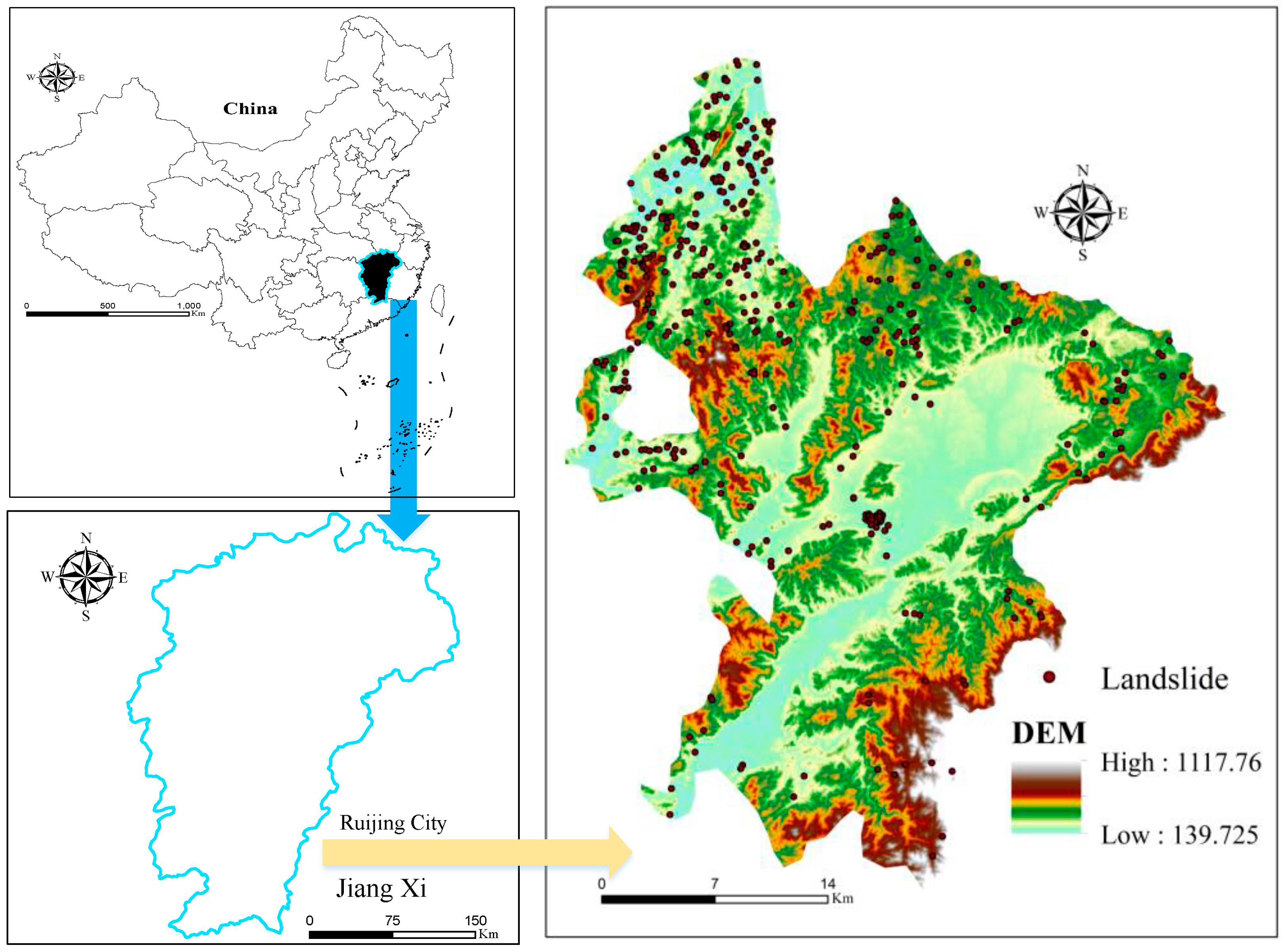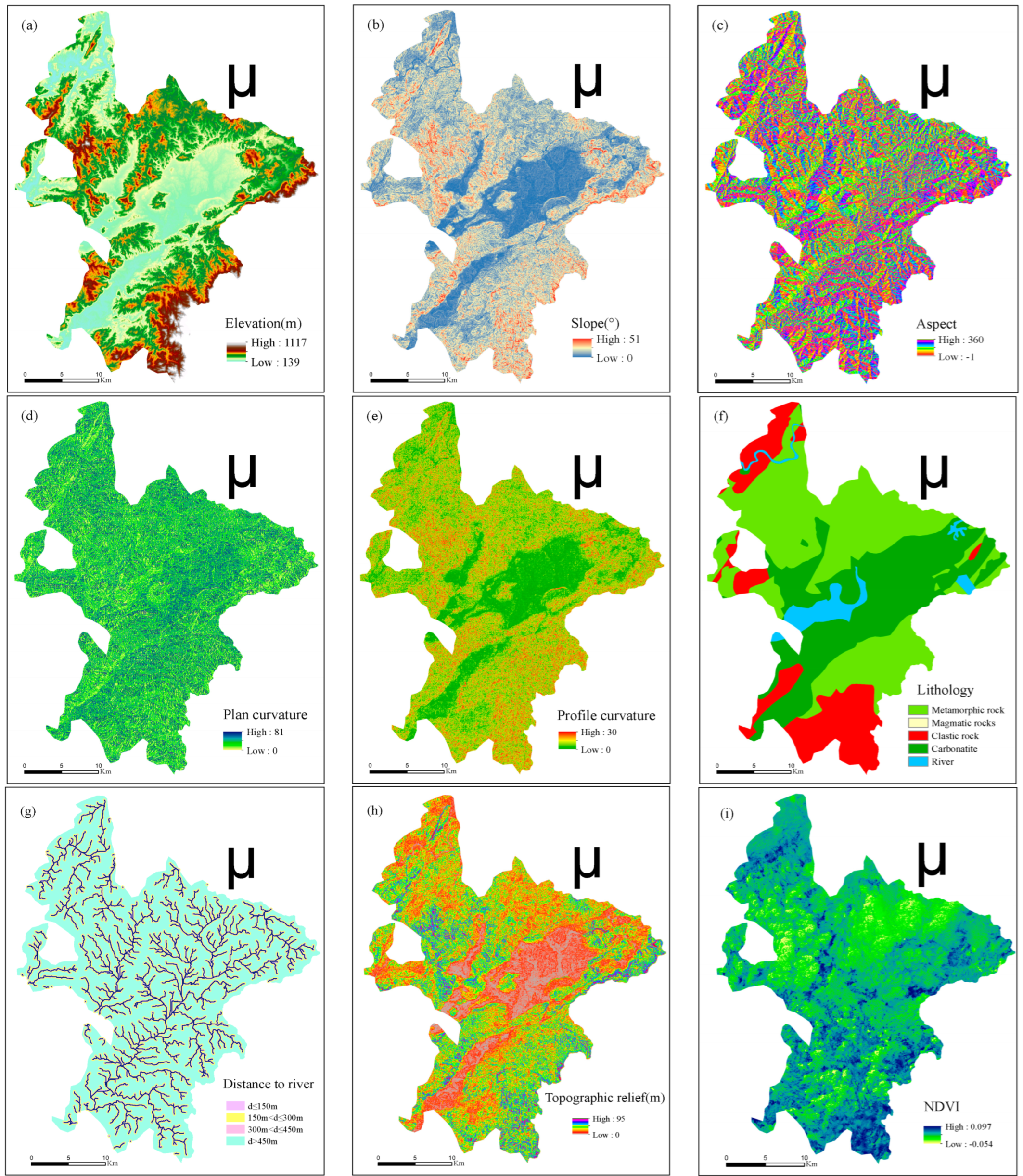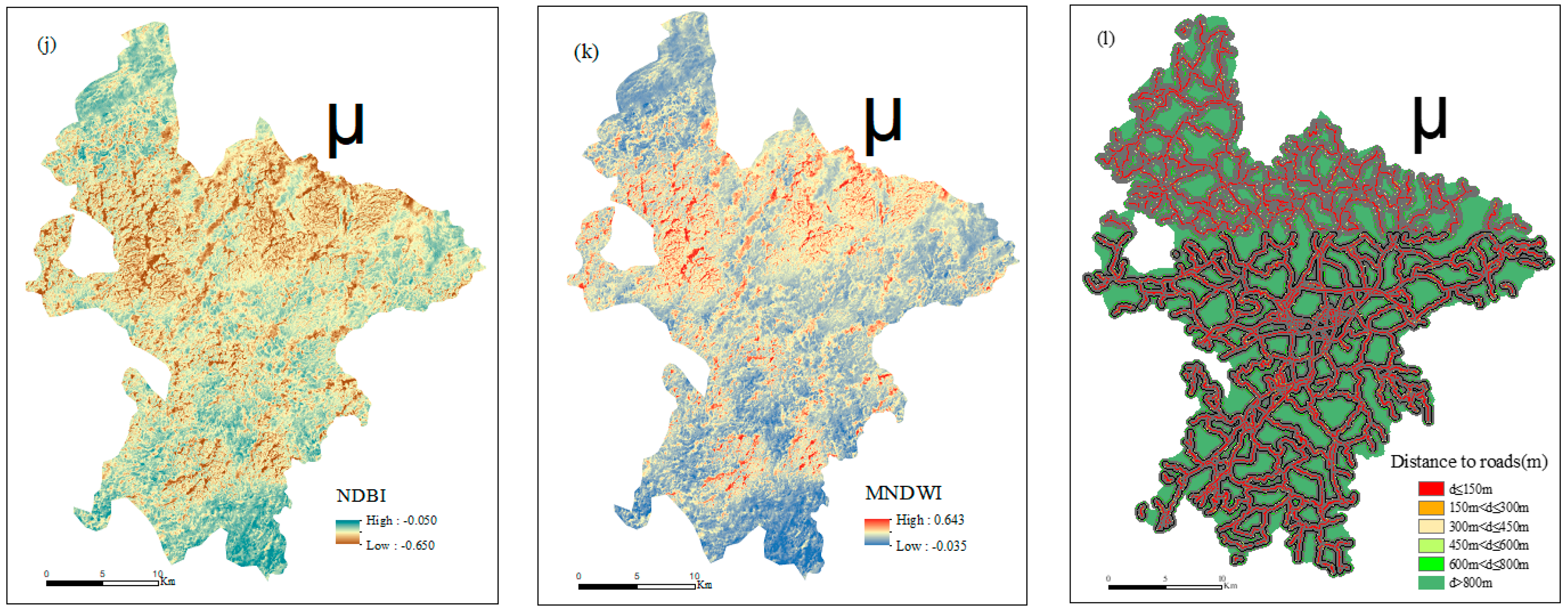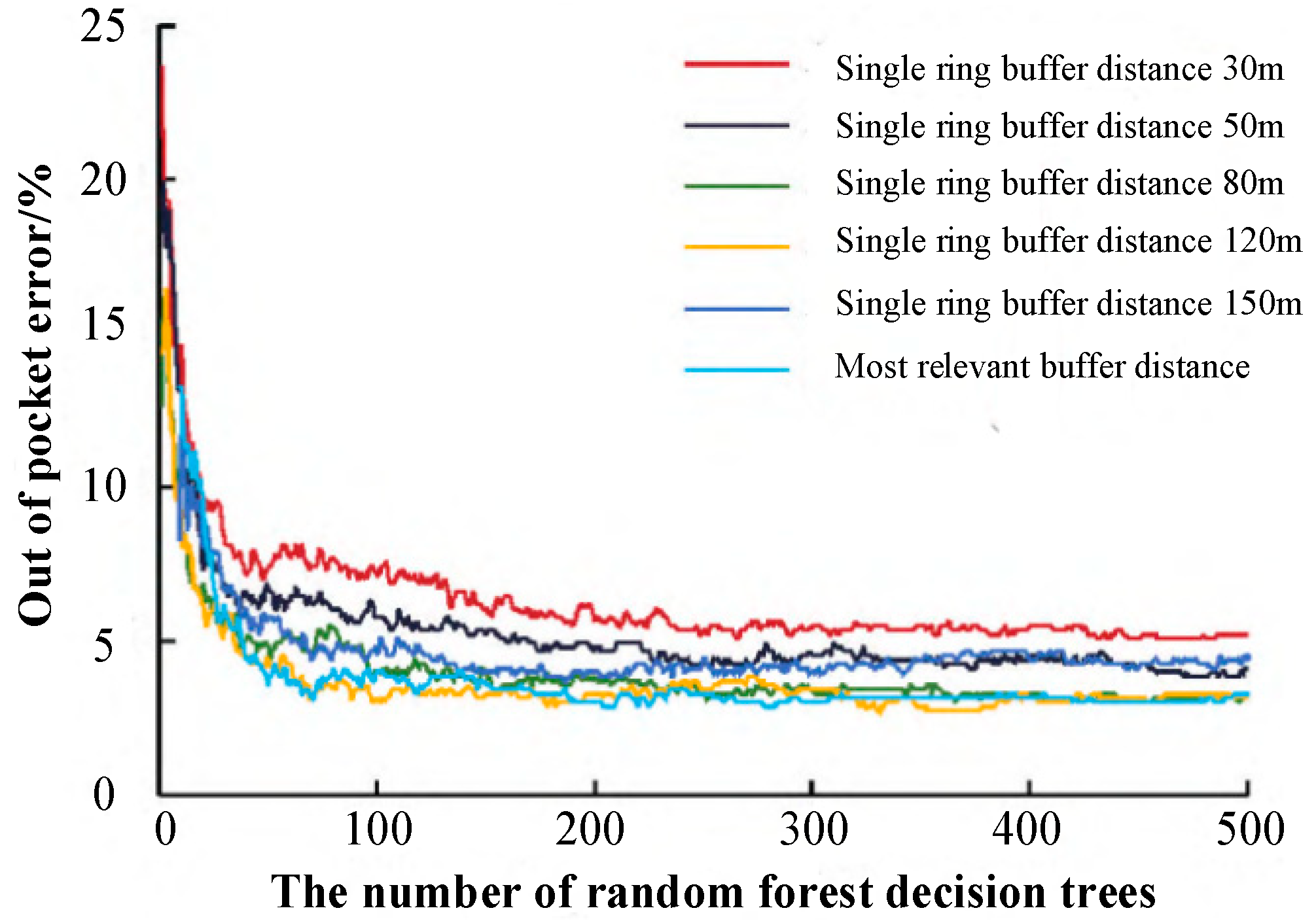Analysis of Optimal Buffer Distance for Linear Hazard Factors in Landslide Susceptibility Prediction
Abstract
1. Introduction
2. Susceptibility Modeling Methods
2.1. Subsection
2.2. Frequency Ratio
2.3. Random Forest (RF)
2.4. Uncertainty Evaluation
2.4.1. Kappa Coefficient
2.4.2. Distribution Characteristics of Landslide Susceptibility Index
3. Data Source
3.1. Overview of the Research Area
3.2. Indicator Selection and Data Source
3.3. Environment Factors
- (1)
- Topographical factor
- (2)
- Surface cover factor
- (3)
- Hydrological condition factor
- (4)
- Basic geological factors
- (5)
- Human activity impact factors
4. Buffer Distance Analysis Based on Pearson Model
4.1. Landslide Density
4.2. Pearson Model Establishment and Analysis
5. Optimal Distance Verification
6. Model Predictions
7. Discussion
- (1)
- For regional landslide studies, the sensitivity analysis of impact factors (environmental factors and trigger factors) is one of the difficult points. Moreover, different landslide susceptibility evaluation models have different sensitivities to the landslide evaluation factors. The importance of the 12 environmental factors selected in this paper still has certain limitations and cannot yet fully reflect the degree of influence of landslide evaluation factors on landslides in an objective and realistic way. Therefore, how to find the evaluation factors that play a decisive role in landslide evaluation needs further research.
- (2)
- The number of decision trees is selected by iteratively calculating the out-of-bag error under different numbers of decision trees, and the model parameters are evaluated by combining the confusion matrix to finally obtain the optimal RF parameters. The integrated and stochastic nature of the RF model gives it the advantage of landslide susceptibility modeling that is less affected by disturbances in the data, high judgment accuracy, and effective prevention of overfitting [39]. Some of the literature investigating the performance of machine learning models for predicting landslide susceptibility shows that RF exhibits higher prediction accuracy than other models, such as logistic regression, SVM, and conventional artificial neural networks, and is more suitable for landslide susceptibility mapping [40,41,42,43]. The findings of this paper are more in line with the existing literature.
- (3)
- Slope is an important influence factor of landslide and is one of the important parameters for landslide susceptibility evaluation. In this paper, the non-landslide points are distributed in the flat topographic area of Ruijin City, which ensures the stability and good prediction accuracy of the selected non-landslide points. However, the largest problem of the model is that it overemphasizes the role of slope, and the results of the factor importance ranking in the random forest model show the importance of slope at the top [44,45], resulting in a large area of very high- and high-susceptibility zones in the prediction results of the model and weak identification of stable areas with high slope. The next step of the study will focus on the selection of non-landslide sites.
- (4)
- This paper was conducted in the Ruijin area as the study area, and the experiment verified that the proposed RF model of landslide susceptibility evaluation method has better results. However, experiments and analyses are needed for larger spatial scales and study areas characterized by other geological formations (e.g., fault structures) and hydrogeological conditions to further verify the generalizability of the method proposed in this paper, which is also the focus of the authors’ subsequent research work.
8. Conclusions
- (1)
- There are 370 landslide hazards and historical landslide sites in Ruijin. Landslide hazard development is mainly small- to medium-sized, shallow to medium, earthy or mounded landslides, while large or giant, deep, and rocky landslides are less developed.
- (2)
- The correlation between the landslide density and the distance of linear disaster-causing factors is greatest in the Ruijin area when the single-loop buffer distances of the lithological geological boundary, road, and river factors are 50 m, 30 m, and 30 m, respectively, reflecting the different influence ranges of different factors on landslides. In other areas, the differences in the influence range of different linear factors should be fully considered when building predictive models for landslide susceptibility.
- (3)
- The landslide susceptibility prediction model built with the most correlated single-ring buffer distance combination of linear hazard-causing factors has a low out-of-bag error curve trend, and the validation set accuracy index is overall higher than that of the same single-ring buffer distance combination of linear hazard-causing factors. The most correlated buffer approach is justified in terms of both model accuracy and prediction accuracy.
- (4)
- The RF model effectively reflects the spatial distribution pattern of landslide susceptibility. The very low and low susceptibility areas are mainly distributed in the north and west of Ruijin City, while the very high- and high-susceptibility areas are mainly concentrated in the central zone. According to the results of susceptibility evaluation, corresponding disaster mitigation and prevention measures should be arranged for the above areas.
Author Contributions
Funding
Institutional Review Board Statement
Informed Consent Statement
Data Availability Statement
Acknowledgments
Conflicts of Interest
References
- Huang, F.; Zhang, J.; Zhou, C.; Wang, Y.; Huang, J.; Zhu, L. A deep learning algorithm using a fully connected sparse autoencoder neural network for landslide susceptibility prediction. Landslides 2020, 17, 217–229. [Google Scholar] [CrossRef]
- Huang, F.; Cao, Z.; Jiang, S.H.; Zhou, C.; Guo, Z. Landslide susceptibility prediction based on a semi-supervised multiple-layer perceptron model. Landslides 2020, 17, 2919–2930. [Google Scholar] [CrossRef]
- Xing, Y.; Yue, J.; Chen, C.; Cai, D.; Hu, J.; Xiang, Y. Prediction interval estimation of landslide displacement using adaptive chicken swarm optimization-tuned support vector machines. Appl. Intell. 2021, 51, 8466–8483. [Google Scholar] [CrossRef]
- Huang, F.; Cao, Z.; Guo, J.; Jiang, S.H.; Li, S.; Guo, Z. Comparisons of heuristic, general statistical and machine learning models for landslide susceptibility prediction and mapping. Catena 2020, 191, 104580. [Google Scholar] [CrossRef]
- Xing, Y.; Yue, J.; Chen, C.; Qin, Y.; Hu, J. A hybrid prediction model of landslide displacement with risk-averse adaptation. Comput. Geosci. 2020, 141, 104527. [Google Scholar] [CrossRef]
- Huang, F.; Chen, J.; Liu, W.; Huang, J.; Hong, H.; Chen, W. Regional rainfall-induced landslide hazard warning based on landslide susceptibility mapping and a critical rainfall threshold. Geomorphology 2022, 408, 108236. [Google Scholar] [CrossRef]
- Zhang, Q.; Bai, Z.W.; Huang, G.W.; Du, Y.; Wang, D. Review of GNSS landslide monitoring and early warning. Acta Geod. Cartogr. Sin. 2022, 51, 1985–2000. [Google Scholar]
- Deng, L.Z.; Yuan, H.Y.; Zhang, M.Z.; Chen, J.G. Research progress of landslide Deformation monitoring and early warning technology. J. Tsinghua Univ. 2023, 63, 849–864. [Google Scholar]
- Zhan, Z.; Shi, W.; Zhang, M.; Liu, Z.; Peng, L.; Yu, Y.; Sun, Y. Landslide Trail Extraction Using Fire Extinguishing Model. Remote Sens. 2022, 14, 308. [Google Scholar] [CrossRef]
- Shao, P.; Shi, W.; Liu, Z.; Dong, T. Unsupervised change detection using fuzzy topology-based majority voting. Remote Sens. 2021, 13, 3171. [Google Scholar] [CrossRef]
- Tehrani, F.S.; Calvello, M.; Liu, Z.; Zhang, L.; Lacasse, S. Machine learning and landslide studies: Recent advances and applications. Nat. Hazards 2022, 114, 1197–1245. [Google Scholar] [CrossRef]
- Chang, Z.; Du, Z.; Zhang, F.; Huang, F.; Chen, J.; Li, W.; Guo, Z. Landslide Susceptibility Prediction Based on Remote Sensing Images and GIS: Comparisons of Supervised and Unsupervised Machine Learning Models. Remote Sens. 2020, 12, 502. [Google Scholar] [CrossRef]
- Jiang, S.H.; Huang, J.; Huang, F.; Yang, J.; Yao, C.; Zhou, C.B. Modelling of spatial variability of soil undrained shear strength by conditional random fields for slope reliability analysis. Appl. Math. Modell. 2018, 63, 374–389. [Google Scholar] [CrossRef]
- Chang, Z.; Catani, F.; Huang, F.; Liu, G.; Meena, S.R.; Huang, J.; Zhou, C. Landslide susceptibility prediction using slope unit-based machine learning models considering the heterogeneity of conditioning factors. J. Rock Mech. Geotech. Eng. 2022, 15, 1127–1143. [Google Scholar] [CrossRef]
- Li, J.; Zhou, C.H. Grid size in the raster-based GIS landslide risk evaluation method Analysis of grid size selection in raster-based GIS landslide risk evaluation method. J. Remote Sens. 2003, 7, 86–92. [Google Scholar]
- Yin, K.L.; Zhu, L.F. Study on spatial zoning of landslide hazards and GIS application. Geol. Geol. 2001, 8, 279–284. [Google Scholar]
- Cao, H.Y.; Chen, J.H.; Gao, Y.L. Analysis of GIS-based fault structure on landslide hazard development Analysis of the control role of fault structure on landslide hazard development based on GIS—Take Yucheng District of Ya’an City as an example. Earth Environ. 2012, 40, 595–598. [Google Scholar]
- Ma, J.; Nian, Y.; Cai, D. Factors of regional landslide risk and correlation between landslide and geology structure in Lanzhou area. J. Nat. Disasters 2006, 15, 14–17. [Google Scholar]
- Xing, Y.; Yue, J.; Guo, Z.; Chen, Y.; Hu, J.; Trave, A. Large-scale landslide susceptibility mapping using an integrated machine learning model: A case study in the Lvliang mountains of China. Front. Earth Sci. 2021, 9, 722491. [Google Scholar] [CrossRef]
- Akinci, H.; Kilicoglu, C.; Dogan, S. Random forest-based landslide susceptibility mapping in coastal regions of Artvin, Turkey. ISPRS Int. J. Geo-Inf. 2020, 9, 553. [Google Scholar] [CrossRef]
- Xing, Y.; Yue, J.; Chen, C. Interval estimation of landslide displacement prediction based on time series decomposition and long short-term memory network. IEEE Access 2019, 8, 3187–3196. [Google Scholar] [CrossRef]
- Huang, F.; Yan, J.; Fan, X.; Yao, C.; Huang, J.; Chen, W.; Hong, H. Uncertainty pattern in landslide susceptibility prediction modelling: Effects of different landslide boundaries and spatial shape expressions. Geosci. Front. 2022, 13, 101317. [Google Scholar] [CrossRef]
- Lucchese, L.V.; de Oliveira, G.G.; Pedrollo, O.C. Investigation of the influence of nonoccurrence sampling on landslide susceptibility assessment using Artificial Neural Networks. Catena 2021, 198, 105067. [Google Scholar] [CrossRef]
- Yunus, A.P.; Fan, X.; Subramanian, S.S.; Jie, D.; Xu, Q. Unraveling the drivers of intensified landslide regimes in Western Ghats, India. Sci. Total Environ. 2021, 770, 145357. [Google Scholar] [CrossRef]
- Yan, F.; Zhang, Q.; Ye, S.; Ren, B. A novel hybrid approach for landslide susceptibility mapping integrating analytical hierarchy process and normalized frequency ratio methods with the cloud model. Geomorphology 2019, 327, 170–187. [Google Scholar] [CrossRef]
- Chen, L.; Guo, H.; Gong, P.; Yang, Y.; Zuo, Z.; Gu, M. Landslide susceptibility assessment using weights-of-evidence model and cluster analysis along the highways in the Hubei section of the Three Gorges Reservoir Area. Comput. Geosci. 2021, 156, 104899. [Google Scholar] [CrossRef]
- Chen, W.; Xie, X.; Wang, J.; Pradhan, B.; Hong, H.; Bui, D.T.; Duan, Z.; Ma, J. A comparative study of logistic model tree, random forest, and classification and regression tree models for spatial prediction of landslide susceptibility. Catena 2017, 151, 147–160. [Google Scholar] [CrossRef]
- Tanyu, B.F.; Abbaspour, A.; Alimohammadlou, Y.; Tecuci, G. Landslide susceptibility analyses using Random Forest, C4. 5, and C5. 0 with balanced and unbalanced datasets. Catena 2021, 203, 105355. [Google Scholar] [CrossRef]
- Krkač, M.; Špoljarić, D.; Bernat, S.; Arbanas, S.M. Method for prediction of landslide movements based on random forests. Landslides 2017, 14, 947–960. [Google Scholar] [CrossRef]
- Talukdar, S.; Singha, P.; Mahato, S.; Pal, S.; Liou, Y.A.; Rahman, A. Land-use land-cover classification by machine learning classifiers for satellite observations—A review. Remote Sens. 2020, 12, 1135. [Google Scholar] [CrossRef]
- Goetz, J.N.; Brenning, A.; Petschko, H.; Leopold, P. Evaluating machine learning and statistical prediction techniques for landslide susceptibility modeling. Comput. Geosci. 2015, 81, 1–11. [Google Scholar] [CrossRef]
- Dou, J.; Yunus, A.P.; Bui, D.T.; Merghadi, A.; Sahana, M.; Zhu, Z.; Chen, C.W.; Khosravi, K.; Yang, Y.; Pham, B.T. Assessment of advanced random forest and decision tree algorithms for modeling rainfall-induced landslide susceptibility in the Izu-Oshima Volcanic Island, Japan. Sci. Total Environ. 2019, 662, 332–346. [Google Scholar] [CrossRef]
- Sun, D.; Wen, H.; Wang, D.; Xu, J. A random forest model of landslide susceptibility mapping based on hyperparameter optimization using Bayes algorithm. Geomorphology 2020, 362, 107201. [Google Scholar] [CrossRef]
- Lin, W.; Yin, K.; Wang, N.; Xu, Y.; Guo, Z.; Li, Y. Landslide hazard assessment of rainfall-induced landslide based on the CF-SINMAP model: A case study from Wuling Mountain in Hunan Province, China. Nat. Hazards 2021, 106, 679–700. [Google Scholar] [CrossRef]
- Wang, W.; He, Z.; Han, Z.; Li, Y.; Dou, J.; Huang, J. Mapping the susceptibility to landslides based on the deep belief network: A case study in Sichuan Province, China. Nat. Hazards 2020, 103, 3239–3261. [Google Scholar] [CrossRef]
- Cui, W.; Liu, G.; Yu, F.; Zhang, X.; Sun, C. Analysis of buffer distance size selection in buffer-based GIS fault and landslide correlation analysis. J. Jiamusi Univ. Nat. Sci. Ed. 2020, 38, 4–8. [Google Scholar]
- Hadmoko, D.S.; Lavigne, F.; Samodra, G. Application of a semiquantitative and GIS-based statistical model to landslide susceptibility zonation in Kayangan Catchment, Java, Indonesia. Nat. Hazards 2017, 87, 437–468. [Google Scholar] [CrossRef]
- Kumar, D.; Thakur, M.; Dubey, C.S.; Shukla, D.P. Landslide susceptibility mapping & prediction using support vector machine for Mandakini River Basin, Garhwal Himalaya, India. Geomorphology 2017, 295, 115–125. [Google Scholar]
- Wu, R.Z.; Hu, X.D.; Mei, H.B.; He, J.Y.; Yang, J.Y. Spatial susceptibility assessment of landslides based on random forest: A case study from Hubei section in the Three Gorges Reservoir Area. Earth Sci. 2021, 46, 321–330. [Google Scholar]
- Achour, Y.; Pourghasemi, H.R. How do machine learning techniques help in increasing accuracy of landslide susceptibility maps? Geosci. Front. 2020, 11, 871–883. [Google Scholar] [CrossRef]
- Merghadi, A.; Yunus, A.P.; Dou, J.; Whiteley, J.; ThaiPham, B.; Bui, D.T.; Avtra, R.; Abderrahmane, B. Machine learning methods for landslide susceptibility studies: A comparative overview of algorithm performance. Earth-Sci. Rev. 2020, 207, 103225. [Google Scholar] [CrossRef]
- Shahri, A.A.; Spross, J.; Johansson, F.; Larsson, S. Landslide susceptibility hazard map in southwest Sweden using artificial neural network. Catena 2019, 183, 104225. [Google Scholar] [CrossRef]
- Huang, F.; Chen, J.; Tang, Z.; Fan, X.; Huang, J.; Zhou, C.; Chang, Z. Uncertainties of landslide susceptibility prediction under different spatial resolutions and different proportions of training and testing datasets. Chin. J. Rock Mech. Eng. 2021, 40, 1155–1169. [Google Scholar]
- Choi, J.; Oh, H.J.; Won, J.S.; Lee, S. Validation of an artificial neural network model for landslide susceptibility mapping. Environ. Earth Sci. 2011, 60, 473–483. [Google Scholar] [CrossRef]
- Zhou, X.; Wu, W.; Lin, Z.; Zhang, G.; Chen, R.; Song, Y.; Wang, Z.; Lang, T.; Qin, Y.; Ou, P.; et al. Zonation of landslide susceptibility in Ruijin, Jiangxi, China. Int. J. Environ. Res. Public Health 2021, 18, 5906. [Google Scholar] [CrossRef]








| Environmental Factors | Values | Number of Grids in the Whole Area | Grid Scale/% | Landslide Grid | Landslide Grid Scale/% | FR |
|---|---|---|---|---|---|---|
| Elevation (m) | 139.7~250.9 | 836,745 | 30.419 | 173 | 46.757 | 1.152 |
| 250.9~335.3 | 796,482 | 28.956 | 121 | 32.703 | 1.175 | |
| 335.3~423.5 | 578,691 | 21.038 | 49 | 13.243 | 0.796 | |
| 423.5~538.6 | 332,056 | 12.072 | 20 | 5.405 | 0.650 | |
| 538.6~695.9 | 147,930 | 5.378 | 4 | 1.081 | 0.159 | |
| 695.9~1117.8 | 58,787 | 2.137 | 3 | 0.811 | 0.376 | |
| Slope (°) | 0~4.4 | 685,218 | 24.911 | 41 | 11.081 | 0.260 |
| 4.4~8.8 | 643,535 | 23.395 | 125 | 33.784 | 0.986 | |
| 8.8~13.2 | 608,755 | 22.131 | 113 | 30.541 | 1.276 | |
| 13.2~17.9 | 446,520 | 16.233 | 56 | 15.135 | 1.945 | |
| 17.9~28.7 | 344,703 | 12.532 | 34 | 9.189 | 0.632 | |
| 28.7~51.2 | 21,960 | 0.798 | 1 | 0.270 | 0.398 | |
| Aspect | −1 | 155,940 | 5.669 | 27 | 7.297 | 0 |
| 0~22.5 | 297,924 | 10.831 | 31 | 8.378 | 0.994 | |
| 22.5~67.5 | 354,479 | 12.887 | 62 | 15.757 | 0.954 | |
| 67.5~112.5 | 359,791 | 13.080 | 48 | 12.973 | 1.301 | |
| 112.5~157.5 | 332,830 | 12.099 | 54 | 14.595 | 1.198 | |
| 157.5~202.5 | 332,143 | 12.075 | 42 | 11.351 | 1.160 | |
| 202.5~247.5 | 378,011 | 13.742 | 48 | 12.973 | 1.086 | |
| 247.5~292.5 | 370,195 | 13.458 | 38 | 10.270 | 0.792 | |
| 292.5~337.5 | 169,378 | 6.158 | 20 | 5.405 | 0.716 | |
| Profile curvature | 0~2.029 | 884,499 | 32.156 | 98 | 26.486 | 0.596 |
| 2.029~4.057 | 773,416 | 28.117 | 125 | 33.784 | 1.072 | |
| 4.057~6.324 | 561,551 | 20.415 | 69 | 18.649 | 1.126 | |
| 6.324~8.949 | 324,376 | 11.793 | 54 | 14.595 | 1.213 | |
| 8.949~14.529 | 187,647 | 6.822 | 23 | 6.216 | 0.823 | |
| 14.529~30.428 | 19,202 | 0.698 | 1 | 0.270 | 1.829 | |
| Plan curvature | 0~13.422 | 651,677 | 23.691 | 111 | 30.000 | 1.246 |
| 13.422~24.927 | 625,675 | 22.746 | 99 | 26.757 | 1.417 | |
| 24.927~37.710 | 471,544 | 17.143 | 58 | 15.676 | 1.434 | |
| 37.710~52.091 | 354,666 | 12.894 | 42 | 11.351 | 0.932 | |
| 52.091~67.749 | 301,696 | 10.968 | 24 | 6.486 | 0.657 | |
| 67.749~81.491 | 345,433 | 12.558 | 36 | 9.729 | 0.852 | |
| Topographic relief | 0~6.022 | 651,450 | 23.683 | 35 | 9.459 | 0.476 |
| 6.022~12.420 | 721,236 | 26.220 | 148 | 40.000 | 0.566 | |
| 12.420~18.819 | 641,938 | 23.337 | 104 | 28.108 | 1.163 | |
| 18.819~22.969 | 293,597 | 10.674 | 43 | 11.622 | 2.575 | |
| 22.969~35.379 | 385,799 | 14.026 | 38 | 10.270 | 0.431 | |
| 35.379~95.975 | 72,855 | 2.649 | 3 | 0.811 | 0.367 | |
| Lithology | Metamorphic rock | 1,218,584 | 44.301 | 108 | 29.189 | 1.301 |
| Magmatic rock | 503,748 | 18.314 | 27 | 7.297 | 1.611 | |
| Clastic rock | 899,363 | 32.696 | 19 | 5.135 | 0.209 | |
| Carbonatite | 128,996 | 4.689 | 216 | 58.378 | 0.659 | |
| NDVI | −0.054~0.006 | 68,098 | 2.476 | 5 | 1.351 | 0.192 |
| 0.006~0.018 | 299,115 | 10.874 | 34 | 9.189 | 0.803 | |
| 0.018~0.025 | 580,373 | 21.099 | 56 | 15.135 | 1.009 | |
| 0.025~0.033 | 848,420 | 30.843 | 146 | 39.459 | 0.955 | |
| 0.033~0.042 | 635,132 | 23.089 | 87 | 23.514 | 1.075 | |
| 0.042~0.098 | 315,488 | 11.469 | 42 | 11.351 | 1.141 | |
| NDBI | −0.650~−0.389 | 74,963 | 2.725 | 13 | 3.513 | 1.101 |
| −0.389~−0.318 | 234,632 | 8.529 | 28 | 7.568 | 0.928 | |
| −0.318~−0.267 | 428,674 | 15.584 | 58 | 15.676 | 1.418 | |
| −0.267~−0.219 | 699,581 | 25.433 | 92 | 24.865 | 1.233 | |
| −0.219~−0.173 | 803,445 | 29.209 | 110 | 29.729 | 0.901 | |
| −0.173~−0.050 | 505,331 | 18.371 | 69 | 18.649 | 0.729 | |
| MNDWI | −0.035~0.110 | 365,882 | 13.301 | 48 | 12.973 | 1.374 |
| 0.110~0.164 | 773,621 | 28.125 | 118 | 31.892 | 1.221 | |
| 0.164~0.217 | 772,212 | 28.073 | 94 | 25.405 | 0.952 | |
| 0.217~0.276 | 492,158 | 17.892 | 67 | 18.108 | 1.174 | |
| 0.276~0.352 | 256,718 | 9.333 | 29 | 7.838 | 1.082 | |
| 0.352~0.643 | 86,035 | 3.128 | 13 | 3.514 | 0.708 | |
| Distance to river (m) | <150 | 155,212 | 5.642 | 47 | 12.703 | 2.586 |
| 150~300 | 55,808 | 2.029 | 7 | 1.891 | 1.689 | |
| 300~450 | 279,114 | 10.147 | 118 | 31.892 | 0.672 | |
| >450 | 2,274,116 | 82.674 | 198 | 53.514 | 0.497 | |
| Distance to roads (m) | <150 | 265,206 | 31.431 | 112 | 30.270 | 0.963 |
| 150~300 | 366,479 | 28.134 | 90 | 24.324 | 3.139 | |
| 300~450 | 337,201 | 21.789 | 82 | 22.162 | 1.663 | |
| 450~600 | 599,351 | 12.259 | 45 | 12.162 | 0.558 | |
| 600~800 | 773,872 | 6.052 | 34 | 9.189 | 0.327 | |
| >800 | 408,582 | 0.335 | 7 | 1.891 | 0.127 |
| Buffer Distance/m | Recall/% | Kappa Factor/% | Accuracy/% |
|---|---|---|---|
| 30 | 84.05 | 76.45 | 88.20 |
| 50 | 85.63 | 78.40 | 89.18 |
| 80 | 86.79 | 80.36 | 90.16 |
| 100 | 88.24 | 79.12 | 89.61 |
| 150 | 86.79 | 82.48 | 91.22 |
| Most relevant buffer | 88.67 | 83.17 | 91.58 |
| Class | Total Grid Number | Proportion (%) | Landslide Grid Number | Proportion (%) | Landslide Density |
|---|---|---|---|---|---|
| Very high | 587,270 | 21.35 | 243 | 75.95 | 3.076 |
| High | 600,890 | 21.85 | 61 | 13.24 | 0.755 |
| Moderate | 565,391 | 20.55 | 33 | 7.03 | 0.434 |
| Low | 591,490 | 21.50 | 20 | 2.70 | 0.249 |
| Very low | 406,548 | 14.78 | 13 | 1.08 | 0.248 |
Disclaimer/Publisher’s Note: The statements, opinions and data contained in all publications are solely those of the individual author(s) and contributor(s) and not of MDPI and/or the editor(s). MDPI and/or the editor(s) disclaim responsibility for any injury to people or property resulting from any ideas, methods, instructions or products referred to in the content. |
© 2023 by the authors. Licensee MDPI, Basel, Switzerland. This article is an open access article distributed under the terms and conditions of the Creative Commons Attribution (CC BY) license (https://creativecommons.org/licenses/by/4.0/).
Share and Cite
Fang, L.; Wang, Q.; Yue, J.; Xing, Y. Analysis of Optimal Buffer Distance for Linear Hazard Factors in Landslide Susceptibility Prediction. Sustainability 2023, 15, 10180. https://doi.org/10.3390/su151310180
Fang L, Wang Q, Yue J, Xing Y. Analysis of Optimal Buffer Distance for Linear Hazard Factors in Landslide Susceptibility Prediction. Sustainability. 2023; 15(13):10180. https://doi.org/10.3390/su151310180
Chicago/Turabian StyleFang, Lu, Qian Wang, Jianping Yue, and Yin Xing. 2023. "Analysis of Optimal Buffer Distance for Linear Hazard Factors in Landslide Susceptibility Prediction" Sustainability 15, no. 13: 10180. https://doi.org/10.3390/su151310180
APA StyleFang, L., Wang, Q., Yue, J., & Xing, Y. (2023). Analysis of Optimal Buffer Distance for Linear Hazard Factors in Landslide Susceptibility Prediction. Sustainability, 15(13), 10180. https://doi.org/10.3390/su151310180









